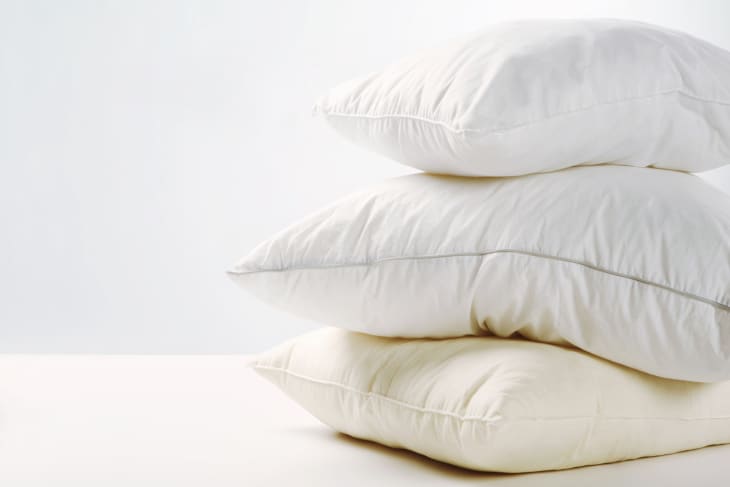How Long Should You Keep a Pillow?

A few weeks ago, after waking up with neck pain for the third day in a row, I realized it might finally be time for a new pillow. I wasn’t happy about it — I loved my pillow dearly. But it was lumpy, and it leaked feathers every time I leaned against it, and under its case it was the mottled yellow color of a mummy’s wrappings. It was also, I realized, approximately 15 years old. This seemed, potentially, very gross.
I decided to reserve judgment until I figured out where I fell on the pillow-grossness spectrum. I crowdsourced a group of friends: “How long do you guys keep your pillows?” Nobody answered; everyone was, I imagined, afraid of being the grossest. “I’ve probably had mine for, like, 12 years…” I added, rounding down. Then the floodgates opened.
“I have a pillow I’ve had since I was like … three?” said Katie, a reporter in her mid-thirties. Some people use the same pillows for years out of little more than habit, but others may do so deliberately, with purpose: “Mine are at least 20 years old, maybe older,” said Leah. “Flat pillows aren’t made. They’re created over years of use.”
“I feel like I’ve heard you’re supposed to replace them every few years? But my family has like, extreme legacy pillows,” said Casey. This “every few years” thing rang a bell, though I can’t tell you if I read that recommendation somewhere, or if it was simply one of those things you “know” and disregard anyway, like “don’t keep leftovers for more than three days.” Was it true? How many pillows was I supposed to have had in the last 15 years that I’d been using this one?
I asked Dr. Joseph Dizon, chief of the Department of Allergy, Asthma and Immunology at the Kaiser Permanente West Los Angeles Medical Center, how long people should keep their pillows, and while he wouldn’t give me an exact number, it seems safe to say the answer is probably fewer than 20 years.
The main problem with keeping a favorite pillow for ages? Dust mites. “Because of the fact that we can shed skin cells on our mattresses and pillows, these are going to be areas that can harbor dust mites,” says Dizon. “The longer you have the pillow, the more likely it is that you’re going to be having a lot of dust mites inhabiting it, especially if you’re not doing anything to reduce the dust mite concentration.”
Dust mites can lead to allergies, which can lead to asthma. While dust mites can’t be entirely prevented, Dizon suggests a number of ways to combat them: using feather pillows instead of synthetic ones (synthetic pillows tend to have more loosely woven casings than feather pillows do, which allows for easier dust-mite travel), using a hypoallergenic cover around your pillow and regular washing.
“Let’s say you have your favorite pillow — and maybe it’s even a synthetic pillow — for more than 10 years, and you’re submerging it in the washing machine and letting it soak in water, then you’re really putting yourself in a better position to not be exposed to dust mites,” says Dizon.
Let’s also say, hypothetically, that you can’t really be bothered to worry as much about dust mites as you ought to, because they’re so tiny, and there are so many other problems to deal with in life. Let’s say you’re mostly worried about the potential effect your gross pillow could have on your skin. I’m thrilled to report that Randy Schueller, cosmetic chemist and co-founder of The Beauty Brains, says that from a skincare perspective, the need to swap out one’s pillow for a new model isn’t “that big of a deal.”
Wearing heavy makeup to bed and sweating all night might, in theory, provide some form of sustenance for bacteria to grow, says Schueller, but it’s pretty unlikely: “Even if your pillow is old, the pillowcase acts as a barrier, and most people wash those fairly frequently,” he says. I tell him that I think that’s being generous, but he says that even if you’re washing your pillow cases once a month, it’s probably not having much of an effect on your skin. Either you’re genetically predisposed to acne, or you’re not. “You need three things [to get acne]: an ingredient that causes this abnormal skin cell behavior, bacteria and excessive oil production,” says Schueller. Getting some makeup on your pillow doesn’t really change that.
There are probably some pretty good reasons to replace your pillow at least twice a lifetime (proper neck support, for one), but the scientific consensus seems to be that there is no real, hardline time limit as to when you need to do it. As long as you’re washing your pillowcases and your pillow itself fairly regularly (and using a hypoallergenic cover, if you want extra credit), you’re fine. You will not keep out every last dust mite and you will not keep in every last feather, but that’s life.